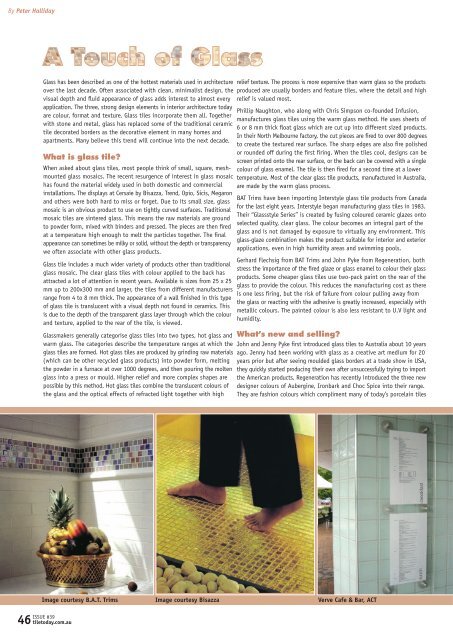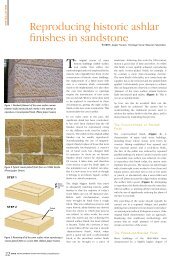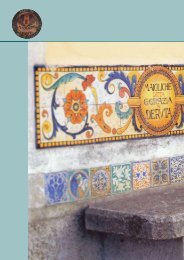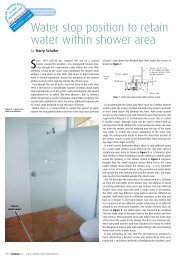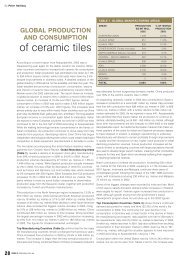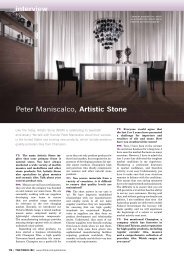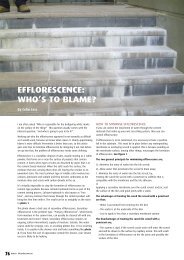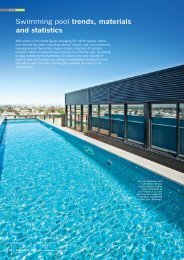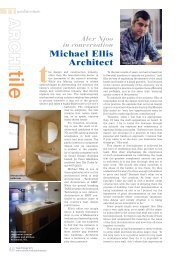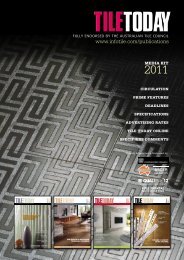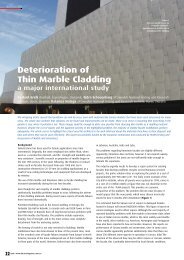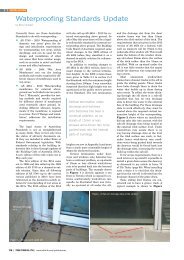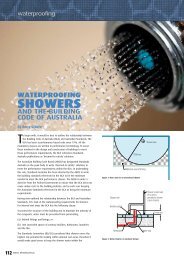What Is glass tile? - Infotile
What Is glass tile? - Infotile
What Is glass tile? - Infotile
Create successful ePaper yourself
Turn your PDF publications into a flip-book with our unique Google optimized e-Paper software.
By Peter Halliday<br />
Glass has been described as one of the hottest materials used in architecture<br />
over the last decade. Often associated with clean, minimalist design, the<br />
visual depth and fl uid appearance of <strong>glass</strong> adds interest to almost every<br />
application. The three, strong design elements in interior architecture today<br />
are colour, format and texture. Glass <strong>tile</strong>s incorporate them all. Together<br />
with stone and metal, <strong>glass</strong> has replaced some of the traditional ceramic<br />
<strong>tile</strong> decorated borders as the decorative element in many homes and<br />
apartments. Many believe this trend will continue into the next decade.<br />
<strong>What</strong> is <strong>glass</strong> <strong>tile</strong>?<br />
When asked about <strong>glass</strong> <strong>tile</strong>s, most people think of small, square, meshmounted<br />
<strong>glass</strong> mosaics. The recent resurgence of interest in <strong>glass</strong> mosaic<br />
has found the material widely used in both domestic and commercial<br />
installations. The displays at Cersaie by Bisazza, Trend, Opio, Sicis, Megaron<br />
and others were both hard to miss or forget. Due to its small size, <strong>glass</strong><br />
mosaic is an obvious product to use on tightly curved surfaces. Traditional<br />
mosaic <strong>tile</strong>s are sintered <strong>glass</strong>. This means the raw materials are ground<br />
to powder form, mixed with binders and pressed. The pieces are then fi red<br />
at a temperature high enough to melt the particles together. The fi nal<br />
appearance can sometimes be milky or solid, without the depth or transparency<br />
we often associate with other <strong>glass</strong> products.<br />
Glass <strong>tile</strong> includes a much wider variety of products other than traditional<br />
<strong>glass</strong> mosaic. The clear <strong>glass</strong> <strong>tile</strong>s with colour applied to the back has<br />
attracted a lot of attention in recent years. Available is sizes from 25 x 25<br />
mm up to 200x300 mm and larger, the <strong>tile</strong>s from different manufacturers<br />
range from 4 to 8 mm thick. The appearance of a wall fi nished in this type<br />
of <strong>glass</strong> <strong>tile</strong> is translucent with a visual depth not found in ceramics. This<br />
is due to the depth of the transparent <strong>glass</strong> layer through which the colour<br />
and texture, applied to the rear of the <strong>tile</strong>, is viewed.<br />
Glassmakers generally categorise <strong>glass</strong> <strong>tile</strong>s into two types, hot <strong>glass</strong> and<br />
warm <strong>glass</strong>. The categories describe the temperature ranges at which the<br />
<strong>glass</strong> <strong>tile</strong>s are formed. Hot <strong>glass</strong> <strong>tile</strong>s are produced by grinding raw materials<br />
(which can be other recycled <strong>glass</strong> products) into powder form, melting<br />
the powder in a furnace at over 1000 degrees, and then pouring the molten<br />
<strong>glass</strong> into a press or mould. Higher relief and more complex shapes are<br />
possible by this method. Hot <strong>glass</strong> <strong>tile</strong>s combine the translucent colours of<br />
the <strong>glass</strong> and the optical effects of refracted light together with high<br />
ISSUE #39<br />
46 <strong>tile</strong>today.com.au<br />
relief texture. The process is more expensive than warm <strong>glass</strong> so the products<br />
produced are usually borders and feature <strong>tile</strong>s, where the detail and high<br />
relief is valued most.<br />
Phillip Naughton, who along with Chris Simpson co-founded Infusion,<br />
manufactures <strong>glass</strong> <strong>tile</strong>s using the warm <strong>glass</strong> method. He uses sheets of<br />
6 or 8 mm thick fl oat <strong>glass</strong> which are cut up into different sized products.<br />
In their North Melbourne factory, the cut pieces are fi red to over 800 degrees<br />
to create the textured rear surface. The sharp edges are also fi re polished<br />
or rounded off during the fi rst fi ring. When the <strong>tile</strong>s cool, designs can be<br />
screen printed onto the rear surface, or the back can be covered with a single<br />
colour of <strong>glass</strong> enamel. The <strong>tile</strong> is then fi red for a second time at a lower<br />
temperature. Most of the clear <strong>glass</strong> <strong>tile</strong> products, manufactured in Australia,<br />
are made by the warm <strong>glass</strong> process.<br />
BAT Trims have been importing Interstyle <strong>glass</strong> <strong>tile</strong> products from Canada<br />
for the last eight years. Interstyle began manufacturing <strong>glass</strong> <strong>tile</strong>s in 1983.<br />
Their “Glassstyle Series” is created by fusing coloured ceramic glazes onto<br />
selected quality, clear <strong>glass</strong>. The colour becomes an integral part of the<br />
<strong>glass</strong> and is not damaged by exposure to virtually any environment. This<br />
<strong>glass</strong>-glaze combination makes the product suitable for interior and exterior<br />
applications, even in high humidity areas and swimming pools.<br />
Gerhard Flechsig from BAT Trims and John Pyke from Regeneration, both<br />
stress the importance of the fi red glaze or <strong>glass</strong> enamel to colour their <strong>glass</strong><br />
products. Some cheaper <strong>glass</strong> <strong>tile</strong>s use two-pack paint on the rear of the<br />
<strong>glass</strong> to provide the colour. This reduces the manufacturing cost as there<br />
is one less fi ring, but the risk of failure from colour pulling away from<br />
the <strong>glass</strong> or reacting with the adhesive is greatly increased, especially with<br />
metallic colours. The painted colour is also less resistant to U.V light and<br />
humidity.<br />
<strong>What</strong>’s new and selling?<br />
John and Jenny Pyke fi rst introduced <strong>glass</strong> <strong>tile</strong>s to Australia about 10 years<br />
ago. Jenny had been working with <strong>glass</strong> as a creative art medium for 20<br />
years prior but after seeing moulded <strong>glass</strong> borders at a trade show in USA,<br />
they quickly started producing their own after unsuccessfully trying to import<br />
the American products. Regeneration has recently introduced the three new<br />
designer colours of Aubergine, Ironbark and Choc Spice into their range.<br />
They are fashion colours which compliment many of today’s porcelain <strong>tile</strong>s<br />
Image courtesy B.A.T. Trims Image courtesy Bisazza Verve Cafe & Bar, ACT
Image courtesy B.A.T. Trims Image courtesy Bisazza Image courtesy Bisazza<br />
Image courtesy B.A.T. Trims<br />
ISSUE #39<br />
<strong>tile</strong>today.com.au??
GET ON BOARD!<br />
THERE IS AN OLD SAYING IN BUSINESS,<br />
“STAY SMALL, GET BIG OR GET OUT!”<br />
We intend to get big and welcome you to join our growth<br />
bandwagon. You want exclusive products, major muscle<br />
when it comes to suppliers, collective advertising clout<br />
and yes, you do enjoy being part of a team.<br />
Franchising is growing like wild fi re across the globe<br />
because the days of truly independent retailers are on<br />
the way out.<br />
We can offer you a very attractive franchise conversion<br />
package where we don’t make any profi ts until we have<br />
proved to you the franchise marketing formula we have<br />
implemented works for you.<br />
Go on, pick up the telephone and give me a call, you<br />
may be pleasantly surprised at what we tell you once<br />
we mutually work out whether we can work together to<br />
build Femme For Tile into a major force in the retail <strong>tile</strong><br />
marketplace.<br />
Our goal is to have 150 <strong>tile</strong> shops across Australia<br />
up and fully operational within the next fi ve years.<br />
Our Cash ‘n Carry ‘keep it simple retailing system’ will set<br />
standards and we want you to be part of that successful<br />
retail formula.<br />
Bronwyn Hudson<br />
Managing Director<br />
Femme For Tile<br />
Tel: 02 9832 8600<br />
Email: b_hudson@tig.com.au<br />
and stone. Like other local manufacturers, Regeneration is not a mass<br />
market manufacturer, but can produce the necessary volumes required for<br />
larger commercial projects. They augment their general range of <strong>glass</strong><br />
borders and wall <strong>tile</strong>s with interesting artistic commissions and custom<br />
made <strong>glass</strong> products.<br />
BAT Trims report that <strong>glass</strong> is still growing in popularity but the styles and<br />
colours are continually changing. The best selling products in projects are<br />
still white or alabaster 100 x 100 mm <strong>tile</strong>s. In domestic applications the<br />
smaller sized mosaic sheets featuring blends of mixed colours has proved<br />
very popular. Gerhard has recently received samples of the new <strong>glass</strong> fl oor<br />
borders also being developed by Interstyle. As the manufacturing technology<br />
improves, the range of interesting products keeps increasing. This has<br />
prompted Gerhard to extend their current warehouse space to carry the<br />
increased number of stock lines held by BAT Trims, who are the largest<br />
stockists of Interstyle products in the world.<br />
Glass products continue to sell well for Gasparre Holdings although Cosimo<br />
Gasparre says the market is changing rapidly. Glass plays a signifi cant part<br />
in their product range with over 300 <strong>glass</strong> products designed in Australia<br />
but manufactured abroad. They have recently introduced new designs featuring<br />
combinations of <strong>glass</strong> with metal in more muted tones. Cosimo believes<br />
<strong>glass</strong> has a strong future, provided his company can meet the market’s<br />
constant demand for new designs, colours and technology.<br />
Infusion has developed a white <strong>glass</strong> <strong>tile</strong> in response to architectural requests.<br />
The clear <strong>tile</strong> with white backing does not have the slight green tinge<br />
normally associated with using fl oat <strong>glass</strong> as the raw material. Chris Simpson<br />
says the low-iron <strong>glass</strong> is more expensive but gives a much whiter result.<br />
Infusion <strong>glass</strong> <strong>tile</strong>s have recently been used as a feature wall in the new<br />
Federation Square project in Melbourne.<br />
Artistic Stone will launch a second range of <strong>glass</strong> <strong>tile</strong>s in early June. Called<br />
the Maniscalco Glass Collection, it includes 32 colours of 15 x 15 mm,<br />
bevelled-edge, full colour <strong>glass</strong> mosaic at very affordable prices, according<br />
to Managing Director, Peter Maniscalco. Mixed colour sheets will be offered<br />
together with borders and centre motifs for swimming pools. The entire<br />
range will be suitable for walls and fl oors, both indoors and outdoors.<br />
Everstone has launched a brilliant range of clear <strong>glass</strong> <strong>tile</strong>s with colour<br />
backing, manufactured in China. The range is available in 40 colours in a<br />
variety of sizes ranging from small mosaic size up to 100 x 100 with long<br />
strips. The modular sizes include oblong shapes that can be combined in<br />
many interesting patterns.<br />
The Spanish decorative <strong>tile</strong> manufacturer Tres Estilos, introduced a new<br />
range of rectifi ed, decorated, tempered <strong>glass</strong> borders at Cersaie in 2002.<br />
The “Fusing Collection” featured again on their display at Cevisama. The<br />
range of <strong>glass</strong> listelli was offered as a modern alternative to the products<br />
normally associated with Spanish <strong>tile</strong> decorators.<br />
How is <strong>glass</strong> used?<br />
Robyn Westall from Academy Tiles says interest in <strong>glass</strong> is huge at the<br />
moment. Academy Tiles use a lot of Bisazza <strong>glass</strong> mosaic for swimming<br />
pools and residential interiors. Though sometimes used on its own, <strong>glass</strong><br />
is usually combined with glazed ceramic <strong>tile</strong>s, porcelain or stone to create<br />
added interest through the use of mixed materials. There is also some<br />
economic advantage in reducing the number of walls, fully <strong>tile</strong>d in an<br />
expensive <strong>glass</strong> mosaic. “Designers are looking for wow factor in tiling<br />
installations and the Bisazza <strong>glass</strong> mosaic range certainly gives plenty of<br />
that. The virtually zero moisture absorption of <strong>glass</strong> makes it ideal for<br />
swimming pools”, says Robyn.<br />
John Pyke describes <strong>glass</strong> as “strikingly neutral”. A popular look is Regeneration’s<br />
thick <strong>glass</strong> border strips combined with large format, rectifi ed wall <strong>tile</strong>s. The<br />
<strong>glass</strong> border protruding beyond the fl at <strong>tile</strong>d surface creates an interesting<br />
look. When lit from overhead, the light dances inside the <strong>glass</strong> border, bringing<br />
the product to life in ways unseen in conventional ceramic borders.
A lot of <strong>glass</strong> <strong>tile</strong> is used for kitchen splash-backs. 100x100 mm is the<br />
most common size but larger formats are also being introduced. John<br />
Pyke recommends using toughened <strong>glass</strong> for sizes larger than 100x100<br />
mm where the <strong>glass</strong> <strong>tile</strong> is close to a heat-source such as a wok burner.<br />
Gerhard Flechsig carried out extensive tests on two ranges from Interstyle,<br />
after their Glasstyle and Glasstains products were specifi ed in an apartment<br />
conversion in Melbourne. A fl ame, measuring 384 degrees Celcius, was<br />
directed 40 mm from the surface of a wall of Glasstains and Glasstyle<br />
100x100 mm <strong>tile</strong>s. The temperature readings to the front, rear and sides<br />
of the <strong>tile</strong> surface confi rmed that the two Interstyle products were suitable<br />
for use in a kitchen environment where gas cook tops were installed close<br />
to the <strong>glass</strong> <strong>tile</strong> wall. No cracks or detrimental effects were found as a result<br />
of the tests.<br />
Installation<br />
Manufacturers’ directions must be carefully followed as the backing colour<br />
on clear <strong>glass</strong> products is translucent. Unsuspecting <strong>tile</strong>rs have used notched<br />
trowels and not properly bedded the material, resulting in notch marks<br />
being seen from the front. This may not be apparent until the adhesive<br />
has dried.<br />
Regeneration reports that some <strong>tile</strong>rs are understandably nervous about<br />
cutting large format <strong>glass</strong> <strong>tile</strong>s that cost over $50.00 each. Many trade<br />
schools are not training installers about <strong>glass</strong> and large formats according<br />
to John Pyke. Regeneration has worked with a number of <strong>tile</strong>rs who they<br />
can now recommend for <strong>glass</strong> installation. As an interesting alternative,<br />
Regeneration will work with a designer to manufacture each <strong>tile</strong> to size<br />
to eliminate all cutting on the job. They will even incorporate the power<br />
point holes at the time of manufacturing.<br />
Glass can be cut with a <strong>tile</strong> cutter, <strong>glass</strong> cutter or wet diamond saw equipped with<br />
a continuous rim blade. Holes should be drilled from the back with a watercooled<br />
diamond drill bit, but fi nished off from the front to prevent chipping.<br />
Metallic backed <strong>glass</strong> should be fi xed with a non-solvent adhesive. Other colour<br />
backed <strong>glass</strong> <strong>tile</strong>s should be installed with a fl exible, waterproof, non-staining,<br />
white adhesive. Bat Trims also recommend the following tip. When grouting the<br />
<strong>tile</strong>, ensure that the grout is left below the fi re rounded edge of the <strong>glass</strong> <strong>tile</strong><br />
to allow extra light refraction within the <strong>tile</strong>.<br />
Future directions<br />
As local suppliers weigh-up the likely future direction of the market, the increasing<br />
amount of well-priced, good quality <strong>glass</strong> coming from China and elsewhere<br />
will make it more diffi cult for local manufacturers to compete on volume product<br />
lines. By maintaining high quality standards and specialised boutique manufacturing<br />
capabilities, local manufacturers will continue to adapt and develop creative<br />
solutions such as making matching <strong>glass</strong> wash bowls to compliment the <strong>glass</strong><br />
<strong>tile</strong>s or borders they sell. Offering different sizes, custom made products and<br />
colours, will ensure the ongoing success of this creative segment of the <strong>tile</strong><br />
industry.<br />
The advent of <strong>glass</strong> as a decorative material is not new. When <strong>glass</strong> <strong>tile</strong> is<br />
combined with other materials, the result is both interesting and can be economical.<br />
Even adding a <strong>glass</strong> strip or small section of <strong>glass</strong> <strong>tile</strong>, will give a project that<br />
extra touch of class, or rather, touch of <strong>glass</strong>.<br />
ARCTIGLASS<br />
is a stunning new kind<br />
of <strong>glass</strong> which features<br />
three excellent products.<br />
Sugarcubes A pure white<br />
sugar dusted translucent<br />
surface<br />
Fireworks A refl ective <strong>glass</strong><br />
available in 8 vibrant<br />
colours<br />
Starlights (featured) Which<br />
boasts 7 soft glossy tints.<br />
These products are available<br />
in a variety of sizes. Large<br />
modules of 10 X 10 cm are<br />
supplied loose, smaller pieces<br />
are pre-sheeted<br />
FOR MORE INFORMATION:<br />
HEAD OFFICE<br />
PO Box 4108<br />
DANDENONG SOUTH VIC 3164<br />
+61 3 9792 3638<br />
Fax: +61 3 9794 9114<br />
E-mail: sales@battrims.com


